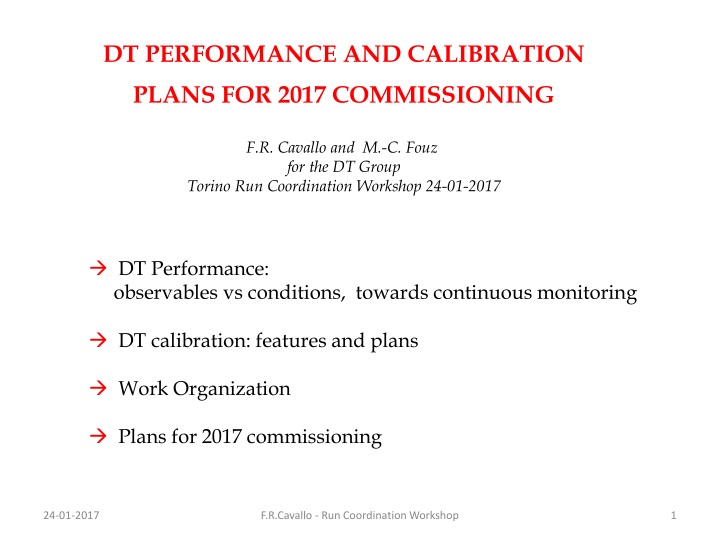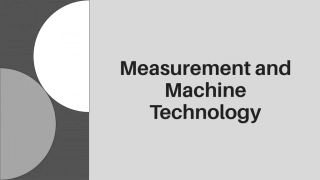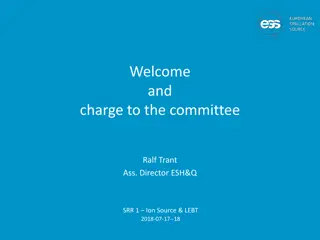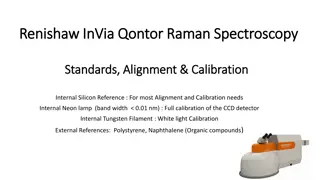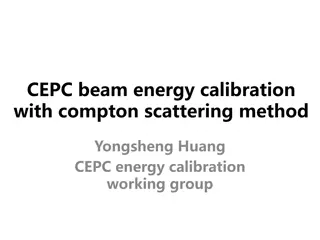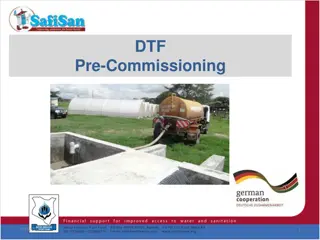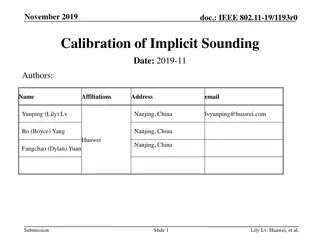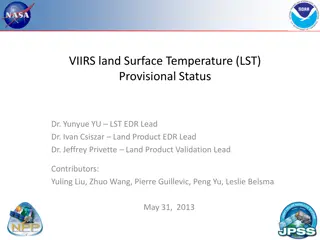DT Performance and Calibration Plans for 2017 Commissioning
This content discusses performance observables, conditions, and calibration plans for the 2017 commissioning of the F.R. Cavallo and M.-C. Fouz's DT Group Torino Run Coordination Workshop. It covers topics such as local trigger efficiency, hit efficiency, hit spatial resolution, and more. The focus is on continuous monitoring and improving efficiency in various aspects related to the DT system.
Download Presentation

Please find below an Image/Link to download the presentation.
The content on the website is provided AS IS for your information and personal use only. It may not be sold, licensed, or shared on other websites without obtaining consent from the author.If you encounter any issues during the download, it is possible that the publisher has removed the file from their server.
You are allowed to download the files provided on this website for personal or commercial use, subject to the condition that they are used lawfully. All files are the property of their respective owners.
The content on the website is provided AS IS for your information and personal use only. It may not be sold, licensed, or shared on other websites without obtaining consent from the author.
E N D
Presentation Transcript
DT PERFORMANCE AND CALIBRATION PLANS FOR 2017 COMMISSIONING F.R. Cavallo and M.-C. Fouz for the DT Group Torino Run Coordination Workshop 24-01-2017 DT Performance: observables vs conditions, towards continuous monitoring DT calibration: features and plans Work Organization Plans for 2017 commissioning 24-01-2017 F.R.Cavallo - Run Coordination Workshop 1
DT PERFORMANCE Observables * Local Trigger efficiency (and quality) * Hit efficiency * Efficiency to associate hits to reconstructed track segments * Hit spatial resolution * Segment time resolution * (Background) Conditions * Instantaneous Luminosity * Pile-Up * Time * (Integrated Luminosity) 24-01-2017 F.R.Cavallo - Run Coordination Workshop 2
DT LOCAL TRIGGER AND TWINMUX SUPER-PRIMITIVE EFFICIENCY In 2016 the TwinMux trigger system became operational (details in Gianni s talk). It allows to merge DT and RPC information for any station. The usage of this merged information was optimized with several rounds of tests and offline analysis. The chosen algorithm consists in: * Matching DT primitive and RPC cluster in space ( 15 mrad) and time ( 1BX ). * Unless the quality of the DT primitive is maximum (8 associated hits), the BX assignment is given by RPC. Improving BX assignment means increasing efficiency, especially in the high regions where the DT timing is spoiled by non uniform B-field. Average efficiency increase was measured to be 1.3% S. Marcellini 24-01-2017 F.R.Cavallo - Run Coordination Workshop 3
DT LOCAL TRIGGER EFFICIENCY Check depenence on Luminosity and Pile-Up. No trend still visible in the considered ranges. Tools for continuous monitoring are being set-up. S. Marcellini 24-01-2017 F.R.Cavallo - Run Coordination Workshop 4
DT HIT EFFICIENCY VS INST. LUMINOSITY (AND PU) * Luminosity and PU strongly correlated within most data samples collected in 2016 (here only Lumi is shown) * Monitoring is needed especially for hottest chambers: MB1 s in YB+-2, and top MB4 s. * Very mild trend visible in layers of MB1 s: all wheels but YB0 MB1 layers MB4 Sec4+Sec13 MB1 layers 24-01-2017 F.R.Cavallo - Run Coordination Workshop 5
DT HIT EFFICIENCY VS RUN NUMBER (~ TIME) 2016C 2016H Monitoring efficiency vs time (better, in the future: vs Integrated Luminosity) aims at spotting early hints of detector ageing. MB1 layers (None from 2016C to 2016H) 2016C 2016H 2016C 2016H MB4 Sec4 +Sec13 MB1 layers Run range Run range 24-01-2017 F.R.Cavallo - Run Coordination Workshop 6
DT HIT ASSOCIATION EFFICIENCY VS INST. LUMINOSITY (AND PU) MB1 layers In order to consider a layer efficient, not only a hit must be found within the tube where it is expected, but it must also be aligned with hits in other layers. Hit multiplicity has more significant effect on this efficiency, due to the TDC dead time: * it is visible in most MB1 s layers. * No trend so far in top MB4 s. (No depenence observed on run number) MB1 layers MB4 Sec4+Sec13 24-01-2017 F.R.Cavallo - Run Coordination Workshop 7
DT TIME RESOLUTION The DT time distribution makes visible the 25 ns beam structure. The fit of the central peak provides the DT time resolution = 1.5 ns P. Traczyk ns This time resolution can be computed in slices of run number in order to check its stability vs time. Run slices 24-01-2017 F.R.Cavallo - Run Coordination Workshop 8
DT HIT SPATIAL RESOLUTION Results for spatial resolution on Run2016G are compatible with previous year (see https://twiki.cern.ch/twiki/bin/view/CMSPublic/DTDPGResults201120152 ) N. Amapane We are setting up the tools for regular monitoring 24-01-2017 F.R.Cavallo - Run Coordination Workshop 9
DT CALIBRATION: FEATURES DT calibration consists in determining the two parameters of the linear relationship between the measured drift time and the wanted hit position within the tube: tTrig (intercept) and vdrift (slope). The procedure is based on the minimization of hit residual w.r.t. ro reco-segments and hasn t substantially changed for the last few years. Calibration STEPS: 1. run vdrift calibration using a recent Global Tag as a starting point 2. run tTrig calibration using the newly determined vdrift and minimizing hit residuals 3. repeat step 2. iteratively using each time the tTrig obtained in the previous step (1-2 times) see https://twiki.cern.ch/twiki/bin/viewauth/CMS/DTCalibrationTools DT calibration is run periodically on dedicated data streams, on the Express stream and PromptReco. A few 105events with good muons are required. The framework for automatic handling of the procedure was recently upgraded, tested and deployed. 24-01-2017 F.R.Cavallo - Run Coordination Workshop 10
DT CALIBRATION: PLANS P. Traczyk 24-01-2017 F.R.Cavallo - Run Coordination Workshop 11
P. Traczyk Run2016D Means of residuals in SuperLayer 1 vs time. . . different colors for different wheels 0.05 0 Station 4 0.05 0 Station 3 0.05 0 Station 2 0.05 0 Station 1 -0.05 Run number 24-01-2017 F.R.Cavallo - Run Coordination Workshop 12
DT FINE SYNCHRONIZATION Adjusting the clock of each single DT chamber in order to set it in phase with LHC improves the trigger performance (more primitives found in BX=0) Before fine synch. After fine synch. BX assignment Trigger quality Fine synchronization was performed in August 2016 (thanks to A. Alvarez Fernandez) Since the same clock is used by local trigger and readout (TDC), the calibration also needs to be adjusted after trigger fine synchronization. 24-01-2017 F.R.Cavallo - Run Coordination Workshop 13
ADJUSTING CALIBRATION AFTER DT FINE SYNCHRONIZATION After trigger fine synchronization a time shift was observed in the readout: e.g in the time associated to reconstructed segments Before fine synch. After fine synch. Segment time After adjusting the calibration the residual distribution improved significantly: the release validation test, performed automatically, ... failed! 24-01-2017 F.R.Cavallo - Run Coordination Workshop 14
PROMPT OFFLINE WORK ORGANIZATION Prompt feed-back to RC and DT community is provided by DT DOC 2 shifter See: https://twiki.cern.ch/twiki/bin/viewauth/CMS/DTAnalysisLHCRuns The offline shifter has three main tasks to accomplish: 1) The Prompt Offline Analysis has to be run on the largest run of each fill, the plots must be saved on web and scrutinized. An entry per run should be made in the e-log with a clear, complete yet synthetic report on the problems observed. 2) The Early Run Certification is to be done in real time on the DT workspace within Run Registry, for every run that has been analyzed. 3) The Tree Production should be run by default at least once a week, on large good quality runs, or on demand (from online crew or analysts) Weekly report is given at the DT meeting (Wednesday at 11). Shifts last 1 week. Credits in 2016 were 0.75 points/day. We are organizing procedures and task description for future Muon DOC 3 who is thought to be in charge of continuous trend monitor. (Examples in slides 4-7, 12) 24-01-2017 F.R.Cavallo - Run Coordination Workshop 15
PLANS FOR 2017 COMMISSIONING Commissioning with cosmics * HV scan data-taking and analysis: find/validate lower working points to increase longevity of chambers most exposed to radiation (top MB4 s, high MB1 s). * Compare results to last year, to spot any hints of ageing. Commissioning with early collisions * Calibration Fine Trigger Synchronization Calibration * Check and optimize procedure for continuous monitoring (DOC3 shifter) 24-01-2017 F.R.Cavallo - Run Coordination Workshop 16
BACK-UP 24-01-2017 F.R.Cavallo - Run Coordination Workshop 17
Correlation between Inst. Lumi and PU Within the same beam bunch structure, Pile-Up and Inst. Luminosity are correlated. This was the case for most 2016 data and this is why we only showed the efficiency depenence on luminosity. In principle the two conditions can be decoupled and can have some different effects on our main observables. (e.g. Luminosity is responsible for n-background (asynchronous), PU for track multiplicity in high regions.) So we keep monitoring both. 24-01-2017 F.R.Cavallo - Run Coordination Workshop 18
Hottest DT regions (1) The background caused by High Luminosity/High Pile-Up is concentrated in the top MB4s , that are exposed to neutron gas, and in the high MB1 s, that collect (fragments of) tracks from Minimum Bias. Left: Drift time distribution in top MB4 (Sector 4) Right: Drift time distribution in bottom MB4 (Sector 10) (100K events) Left: Drift time distribution in top MB4 for Lumi < 5 1033 cm-2s-1 Right: Drift time distribution in top MB4 for Lumi > 12 1033cm-2s-1 24-01-2017 F.R.Cavallo - Run Coordination Workshop 19
Hottest DT regions (2) Left: Segment quality distribution in MB1/YB2 Right: Segment quality distribution in MB3/YB0 (100K events) Left: Segment quality distribution in MB1/YB2 for Lumi < 5 1033 cm-2s-1 Right: Segment quality distribution in MB1/YB2 for Lumi > 12 1033cm-2s-1 Both types of background will be monitored regularly. Detailed studies are ongoing to assess their exact dependencies on beam conditions. 24-01-2017 F.R.Cavallo - Run Coordination Workshop 20
Why layers of YB0 have lower efficiency than external wheels x x Hit association efficiency x x cm cm x x x x 24-01-2017 F.R.Cavallo - Run Coordination Workshop 21
